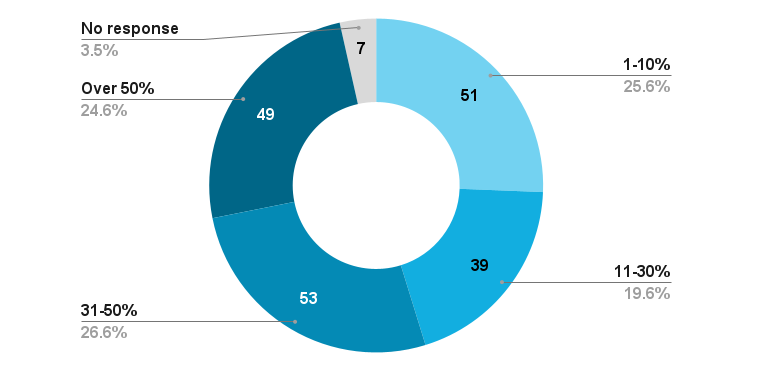Vast majority (193; 96.7%) of the respondents have some form of anonymous peer review. Double-anonymized peer review prevails among the respondents
(167; 83.9%). Two journals only have editorial peer review and in all other cases it’s combined with anonymous peer review. Various forms of open peer review are used only sporadically, in combination with other review types.
Table 9. Peer review types
| Peer review type | # journals |
|---|---|
| Double-anonymized | 167 |
| Single-anonymized | 37 |
| Editorial review | 59 |
| Open identities of the reviewers, authors and editors | 2 |
| Open reviewers' reports | 3 |
| Open participation in the peer review process | 2 |
Most respondents (171; 85.9%) have specific policies/guidelines/instructions on editorial quality (with definition of quality criteria, compliance, peer review process and editorial independence commitment) and research integrity/publication ethics.
Figure 6. The availability of policies/guidelines/instructions on editorial quality and research integrity / publication ethics
Most respondents (159; 79.9%) have up to 20 members in their editorial boards or other editorial bodies, with almost equal shares of those having up to 10 board members (80; 40.2%) and those with 11–20 members (79; 39.7%). The fact that less than 10% of the respondents have editorial boards with more than 30 members confirms that the vast majority of the surveyed journals has manageable editorial boards.
| Size of editorial bodies | # members | % |
|---|---|---|
| No editorial board | 1 | 0.5% |
| 1-10 | 80 | 40.2% |
| 11-20 | 79 | 39.7% |
| More than 20 | 36 | 18.1% |
| Unclear | 3 | 1.5% |
| Total | 199 | 100.0% |
Figure 7. The size of editorial bodies
Approximately one quarter of the respondents (19; 24.6%) have more than 50% of editorial board members from outside of the journal’s country and the share of those with less than 10% of foreign members is almost the same (51; 25.6%).
| Editorial board members from outside the country | # members | % |
|---|---|---|
| 1-10% | 51 | 25.6% |
| 11%-30% | 39 | 19.6% |
| 31-50% | 53 | 26.6% |
| Over 50% | 49 | 24.6% |
| No response | 7 | 3.5% |
| Total | 199 | 100.0% |
Figure 8. The percentage of editorial board members from outside the country
At the same time, nearly half (97; 48.7%) of the respondents have more than half of editorial board members from outside their institutions.
| Editorial board members from outside the institution | # members | % |
|---|---|---|
| 1-10% | 37 | 18.6% |
| 11-30% | 20 | 10.1% |
| 31-50% | 41 | 20.6% |
| Over 50% | 97 | 48.7% |
| No response | 4 | 2.0% |
| Total | 199 | 100.0% |
Figure 9. The percentage of editorial board members from outside the institution
Editorial challenges mentioned include:
- The translation of articles into English.
- Financial compensation for the editor-in-chief, editorial board, and reviewers.
- Geographic diversity of authors.
- Motivation for editors and reviewers.
- Participation of the Editorial Board members.




